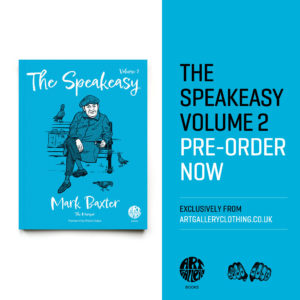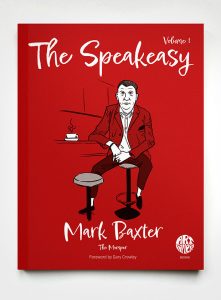
‘In the future, everyone will be famous for fifteen minutes.’
So said artist Andy Warhol in the 1960s. By the time of the quote, he of all people, knew plenty about turning his daily life into ‘art.’ Going by much of the nonsense I see on my daily tours of social media land, I can see plenty of those out there trying to back up what Andy said. Only, from what I’ve seen, many of the ‘social media superstars’ on my feed, would struggle to fill 5 minutes, then alone 15, but hey ho, the genie is well and truly out of that particular bottle. For me, it’s a case of ‘get out of the way grandad, were coming through.’
Anyway, leaving that over there, the whole Warhol thing is an odd one. I can distinctly remember as a little kid hearing his name and then seeing his photograph and wondering what that was? He was truly otherworldly to my young eyes. In his peroxide syrup*, Andy, his art, his companions and his art house films, especially in the mid 60s, made the ‘norms’ in Straight Town, very, very uncomfortable.
He was born Andrew Warhola in August 1928, in the working class area of South Oakland, Pittsburgh, Pennsylvania. Dad was Ondrej, which he later changed later to Andrew, who worked as a miner and his mum was Julia, who looked after Andy and his older brothers. His parents had emigrated from a place called Mikova, which today stands in the North of Slovakia.
A bout of St. Vitus Dance as a kid, a complication of scarlet fever, meant that Andy spent a lot of time in his bedroom, drawing and listening to the radio, which seemed to have the effect of feeding his developing artistic and creative mind.
Upon graduating from High School, he studied commercial art at the Carnegie Institute of Technology in Pittsburgh and he had earned a Bachelor of Fine Arts by 1949. He then moved to New York City to take up a career in illustrating. There, he found work at Vogue and The New Yorker magazines. His advertising work for shoe manufacturer Israel Miller, also gained him a lot of industry interest. Once set up there, he moved the now widowed Julia in with him, and she often contributed the lettering to his early illustrations.
He gradually moved into showing his artwork in galleries, and some of it featured in a Museum of Modern Art show. He also contributed work on book jackets and record sleeves, including for the iconic Blue Note company. He worked all hours and was described as a true workaholic, by those who knew him then. This application to the graft, meant he became very successful and he earned a very good living.
‘Making money is art, and working is art and good business is the best art.’
He self-published a couple of limited edition, numbered books in 1954, namely ’25 Cats Named Sam’ and ‘One Blue Pussy.’ Each illustration was hand coloured. The books were given away to clients and friends, and have become highly collectable over the subsequent years, with one selling at an auction in May 2006 for US$35,000.
In the early 60s, Warhol developed an early interest in the silk screen printing technique. TIME magazine picked up on his early ‘Campbells Soup Can’ work (Warhol claimed he ate the soup every day for lunch) and they ran an article in 1962. For the first time, he now had the press on his tail. Subsequent subjects from him, included famously, prints of Marilyn Monroe, more soup cans, coke bottles, Elvis, Muhammad Ali and Elizabeth Taylor, all of which resulted in Warhol being dubbed ‘The Pope of Pop.’
Critic Robert Hughes, 1971 – ‘Painting a soup can is not in itself a radical act, but what was radical in Warhol was that he adapted the means of production of soup cans to the way he produced paintings, turning them out en masse – consumer art mimicking the process as well as the look of consumer culture.’
Warhol worked out of The Factory, his aluminium foil covered studio and in there on most days, could be found a whole bohemian coterie, including fellow artists, musicians, muses, drag queens, intellectuals, homosexuals, and general hangers on from the outsider, underground circuit. His main assistant was Gerard Malanga and other regular names included in situ included Ondine, Billy Name, Ultra Violet and Brigid Berlin.
1964 saw Warhol first exhibit his wooden box ‘sculptures.’ These had silk screen printed logos upon them, including ‘Brillo’ ‘Heinz’ ‘Kellogg’s’ and his old favourite, ‘Campbells.’ They sold in the region of between $200 – $400 each.
‘I am a deeply superficial person.’
That same year, saw Warhol direct his first film, ‘Sleep’ which consisted of five hours of footage of Warhol’s then lover, the poet John Giorno, asleep . Other names who would soon become part of the Andy story and appear in future films, included Edie Sedgwick, Candy Darling, Joe Dalessandro, and Holly Woodlawn. Eventually, over 60 underground titles were made, and included ‘Kiss’ ‘Chelsea Girls’ ‘Poor Little Rich Girl’ ‘Empire’ ‘Blow Job’ and ‘Batman Dracula.’
1966 saw Warhol and Paul Morrisey manage the band The Velvet Underground, and introduce his ‘superstar’ Nico, to the mix. The resulting debut album by the band sold 30,000 copies and was ‘produced’ by Warhol, who also designed the infamous ‘Banana’ record cover.
Brian Eno – ‘Everyone who bought one of those 30,000 copies, started a band.’
Other celebrated ‘cover art’ by Warhol later included ‘Sticky Fingers’ for the Rolling Stones, resulting in two of the most recognisable images in Pop history.
Infamy and fame then clashed in June 1968, when paranoid schizophrenic, Valerie Solanos, a fairly regular visitor on the fringes of The Factory, but the only member of SCUM – Society for Cutting Up Men – shot Warhol and visiting art critic Mario Amaya, at the studio. Amaya was only injured slightly, but Warhol however was seriously wounded and fortunate to survive the attack. Once recovered, Warhol tightened up security at The Factory and many of his old acquaintances began to stay away . Warhol himself, took a step away from his filmmaking, with Paul Morrisey taking more of a leading role.
‘Before I was shot, I always thought that I was more half-there than all-there—I always suspected that I was watching TV instead of living life. People sometimes say that the way things happen in movies is unreal, but actually it’s the way things happen in life that’s unreal. The movies make emotions look so strong and real, whereas when things really do happen to you, it’s like watching television—you don’t feel anything. Right when I was being shot and ever since, I knew that I was watching television. The channels switch, but it’s all television.’
1969 saw Warhol and B John Wilcock, a journalist from the UK, found ‘Interview’ magazine and the track ‘Andy Warhol’ appears on the David Bowie album ‘Hunky Dory.’
Bowie was never sure if Andy liked it. It has been said subsequently that Warhol didn’t say anything on hearing a playback of the track in Bowie’s presence, but ‘absolutely hated it.’
In 1973, Warhol created his image of Chairman Mao in what in general, was a quieter decade for him. He was still seen out and about however, famously being a regular at the Studio 54 nightclub, seen there with the likes of Liza Minelli and Bianca Jagger.
‘I have a social disease. I have to go out every night.’
In 1979, Warhol and his long-time friend Stuart Pivar, founded the New York Academy of Art, with Andy later lauded as a major influence and mentor by emerging younger artists, such as Julian Schnabel, Keith Haring, Robert Mapplethorpe and Jean Michel Basquiat.
A practising catholic at St. Vincent’s, his regular church, Warhol also quietly volunteered at homeless shelters, serving up food and hot drinks.
A general fear of hospitals meant that he put off the surgery he needed on his gallbladder. He finally went under the knife in February 1987. Sadly, he died of a heart attack in his sleep as he recovered. He was 58.
His immediate family took his body back to Pittsburgh for the funeral service and burial, though a star-studded memorial was later held at St Patricks in New York, in the April of that year, to which 2000 people turned up.
Never mind fifteen minutes, Warhol’s legacy has stretched much further than that, with his art fetching eye watering figures at auction. In 2014, work of his brought in nearly $570 million, and the demand and interest in the art is as strong today as it ever was.
Upon his death, he left the bulk of his estate to be used to set up the Warhol Foundation. An initial sale of his possessions raised a further $20 million. The foundation is consistently one the largest grant giving organisations in the States.
‘I never understood why when you died, you didn’t just vanish, everything could just keep going on the way it was, only you just wouldn’t be there. I always thought I’d like my own tombstone to be blank. No epitaph, and no name. Well, actually, I’d like it to say ‘figment.’
The Mumper of SE5
*Syrup of Figs – Wig.
THE SPEAKEASY VOLUME 2 (PRE ORDER – MARCH DELIVERY)
THE SPEAKEASY Volume Two by Mark Baxter (The Mumper)
Illustrations by Lewis Wharton
Foreword by Rhoda Dakar
Available to PRE ORDER here
*Update – Volume 2 has gone to print & will be delivered soon.
THE SPEAKEASY VOLUME 1
THE SPEAKEASY Volume One by Mark Baxter (The Mumper)
Illustrations by Lewis Wharton
Foreword by Gary Crowley
Available to ORDER here
ART GALLERY CLOTHING
Further items have just been added to our winter SALE
JOIN US
Sign up to our newsletter and receive an exclusive promo code, latest news & Art Gallery Clothing offers.





